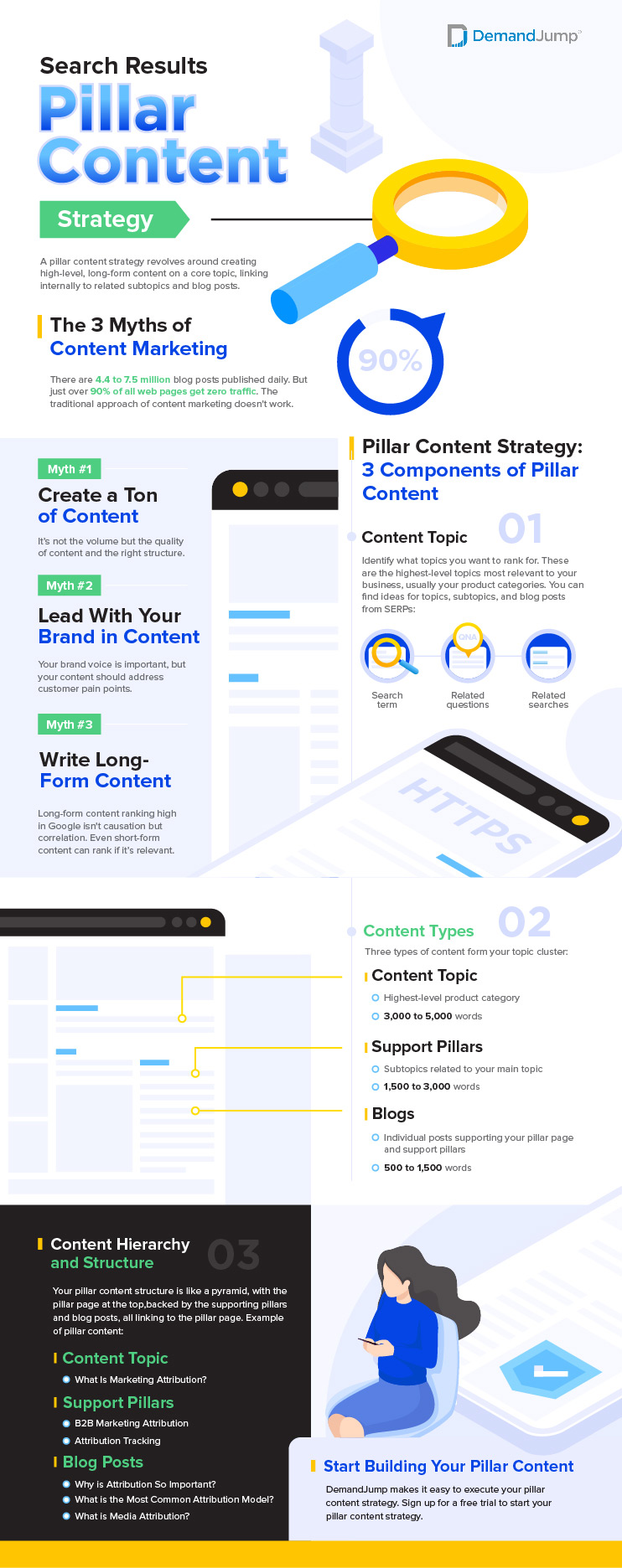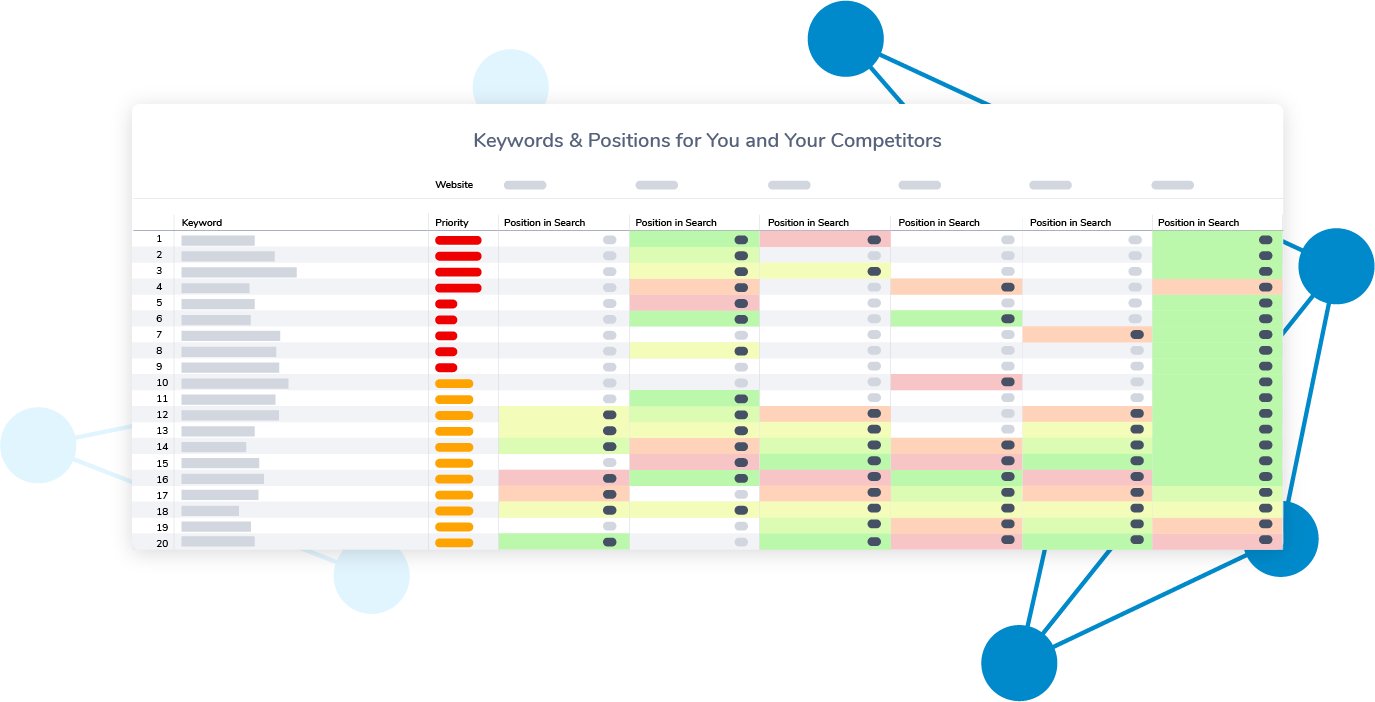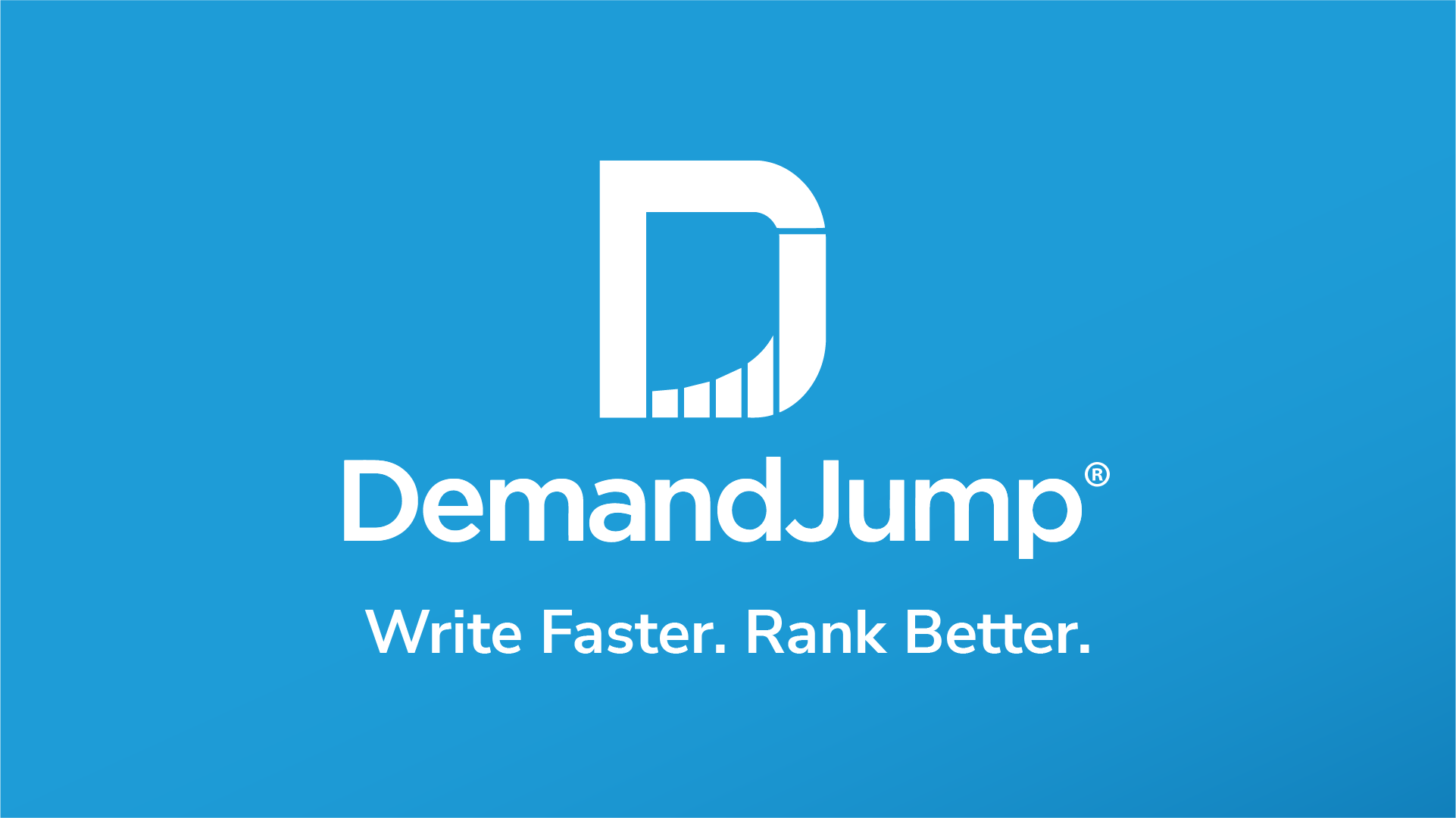We have all heard the phrase content is king, but how true is that statement? Get ready for some insane numbers. As of January 2021, there are 1.18 billion websites in the world. Of those 1.18 billion, only 17% of them are active. Of that active 17%, around 90% of them get zero web traffic from Google! That means that roughly 10% of all active websites on the internet get all of Google's web traffic. If content makes that kind of impact, how can you become part of that 10%?
This piece itself is a pillar and will serve as a way to better understand what a pillar is and how it can positively impact your SEO performance to make sure you end up on the first page of Google, and in that elusive 10%.
What Does the Pillar Page Mean?
Content pillars are an effective way to create layered, interconnected webs of content that always give searchers the chance to dive deeper into the topics they're interested in learning more about. The pillar refers to both a piece of content as well as content strategy. At the top of this strategy is the 3,000 word pillar page(s), which serve as the best opportunity to provide an exhaustive overview of your topic. The pillar is then held up by longer blogs.
These support pillars are around 2,000 words in length and explore sub-topics related to the main pillar or pillars. The support pillars are then, themselves, held up by supporting blogs. The blogs are around 750 words apiece and dive into an even more targeted approach at specific topics related to their respective higher-level topic. If that feels like a lot of information all at once, something to remember throughout the process is that every piece you write must funnel back to the topic/content of the pillar.
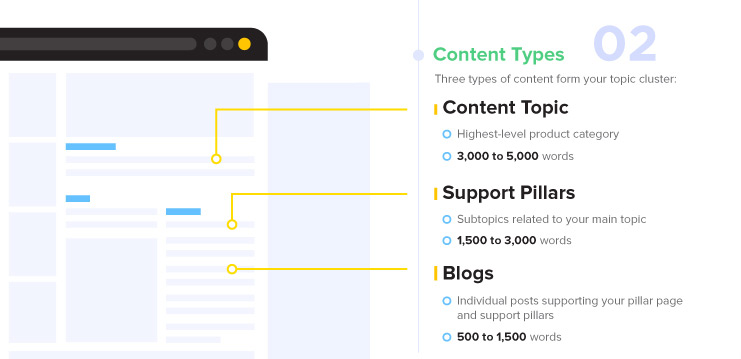
Now that we have a better understanding of what a pillar page is and how the pillar strategy works on a basic level, one might ask questions about terms that are often used interchangeably; “What is a pillar in SEO?” It is a piece of content and a related strategy; "What is pillar content in SEO?”It is the pillar and its related content; “What is a pillar post in SEO?” It is the main piece of content at the center of the strategy. This is how we’ll be referring to them when they are used.
Pillar strategies may feel more like a way to organize your content, but as it pertains to SEO, pillar pages can dramatically increase traffic to your website. Here are just a few ways in which pillar pages can help your overall ranking performance.
- High-Volume Keywords: As it turns out, pillar pages can rank higher for competitive keywords in most cases. This is because Google's AI has improved to identify that users who search generally around a topic will likely want as much information as possible. Therefore, Google favors well-written content that reflects the needs of the user's search.
- More Effective Site Structure: Wait, what? We just said that pillar pages are not just about organization. While this is still true, the structure of your site does impact SEO performance. Google does not look at a web page by itself without context. Instead, Google takes into consideration multiple pieces of content together. Most important for our pillar content and SEO discussion, Google looks at how each page is related. If your site has a lot of content and pillar pages that unify all of the smaller content, this improves your site structure and communicates to Google that you are an authority on the topic. Thus, improving your search results ranking.
- Authority Matters: Speaking of authority, if Google (or other search engines) recognize your site as an authority on a specific subject, you will be placed higher in their respective search results. Both uplinking and interlinking from the supporting blogs and other content can make the pillar become that authoritative piece.
What is the Main Purpose of Pillar Content?
The primary function of any pillar content is to create pieces that use curated keywords to rank higher for what your target audience searches. Google organizes the internet into networks of related terms and questions around big topics. Likewise, the pillar content approach creates a network effect, giving you the ability to rank for long-tail keywords (usually the titles of your supporting blogs) and drive that traffic to the top of the pillar, which is your biggest, richest piece of content at the heart of the network.
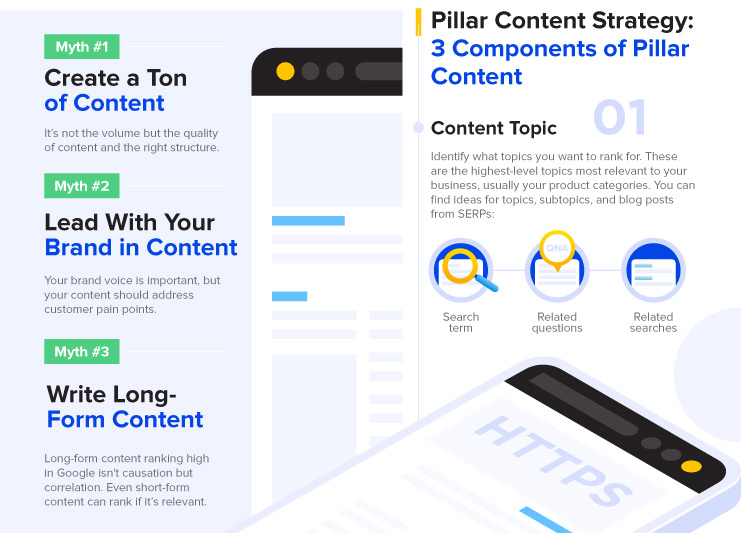
What are Pillar Posts?
The actual pillar posts will look somewhat similar regardless of what topic you are trying to rank for. We know how long they should be, and the goal for creating them, but what is a pillar post? The easiest way to answer that question is by dissecting some pillar post examples.
A perfect place to start would be with one of our very own pillar on SEO keyword research. This specific pillar has 18 keywords that boost the ranking of the piece by covering as many topics and questions related to SEO keyword research as possible. It is not enough to include valuable keywords in the piece. Where you put them and how they are formatted will also help communicate useful information to the search engine.
Heading elements (H1, H2, H3) are used to impact rankings directly, and while they are no longer that powerful, there is still a best way to use them. While an H1 heading is not more important than an H2 or H3 header, it still communicates structure to search engines like Google. If we look at the DemandJump pillar we mentioned previously, the title gets designated by the H1 header, and all other section headers get the H2 designation.
- H1: The H1 tag should include the main point of the post. This is often the title of the post.
- H2: The H2 tags should consist of all of the significant subheadings. Think of H2's as the chapters inside the book of H1. These make your post easy to skim.
- H3: The H3 tags are within the H2's. They help define specific points and better categorize the material.
Types of Pillar Pages
While there are no concrete pillar types, there are a few archetypes that most pillar pages fall under.
- How-To: The how-to pillar page is a fantastic way to establish your organization as an authority or subject matter expert on a topic. The how-to style of pillar is also a great time to showcase what your company offers to the reader. For example, if your pillar is titled "How to Implement a CRM," then as you discuss the best ways to implement the technology, you could speak to how your company could help with the process. A win-win.
- What Is: Due to its length, pillar content lends itself nicely to the "what is" style. This type of pillar page presents the opportunity to express authority on a topic. Using a CRM-related example again, a pillar page titled "What is CRM?" would allow for an entire web page to explore everything a CRM can do. Thus, having Google recognize this piece as an authority on the topic and put it higher in the rankings.
- Guide: This type of pillar page can look quite similar to a how-to pillar as the goal is closely related. The guide is a long-form resource that covers your pillar topic and its subtopics in a large amount of detail.
- Resource: The resource pillar page is made to be a resource of tools, stats, examples, case studies, and anything else your target audience may need when researching your topic. This page is particularly popular as it is easier to create than a comprehensive guide while still boosting SEO performance.
What are your Content Pillars?
How do you know what pillar content is best for your company? The best way to identify if a topic is suitable for a pillar is to break down the process of creating a pillar page.
Step 1: Before jumping into writing all of the juicy content for your pillar, you need to choose the right topic. A great starting point is to identify what you wish you ranked higher for or something that you don't rank at all for but feel it would be beneficial if you did. Looking to your competition is another great resource if you are still unsure of a direction to start with on your content pillar topic. Using the DemandJump platform, you can gain insights on what your audience is searching for and how your competition is ranking.
Your competition may rank for a service you provide as well, therefore creating a pillar around that topic would garner some of those searches over to your site. Whichever topic you ultimately decide on will dictate the direction of the rest of your content.
Step 2: This is where your team needs to work out the topics for each of the pieces of content, pillars, support pillars, and blogs This will help answer some questions like “what is a pillar blog post” or “what are blog content pillars?” By fleshing out the topics for the pillar and supporting content, you will get a better idea of how all of the pieces work together. You can easily get lost in the planning process and forget to have all of your content point back to the pillar, but mapping out the topics will give you a better understanding of the whole strategy. Below is an image of what a pillar content strategy could look like when you partner with DemandJump. The single breaks out into possible support pillars, and the three support pillars selected show possible blog topics.
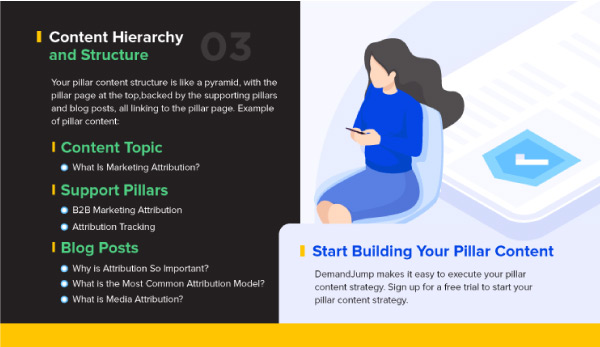
Step 3: The next vital step in creating an effective pillar page is identifying the necessary keywords. These high-value keywords and questions are what will drive organic traffic to your site. Everything from your title to section headers should be a ranking keyword or question. Unsure of what keywords or questions you should be using? That is where an organization like DemandJump comes into play. Our Consumer Insights tool gives you the ability to see what your target audience is searching for every day. You would also gain access to tools that allow you to:
- See how you stack up against competition around any topic or keyword.
- Gain market share with a prioritized list of questions and keywords to create content around.
- Learn about the questions your audience is asking in each stage of the buying process.
Step 4: After all of the planning and research has been conducted, it is time to write, publish, and link the pillar content. Creating your outline around the keywords and questions you have selected will simplify the writing process. Once the pillar is finished, you can move on to creating the support pillars and blogs to go along.
As you write these supporting pieces, they should all link back to the topic presented in the pillar. This linking process creates what is called a content ecosystem. Your blogs will answer more basic and specific questions, which will then link back to the bigger ideas in the support pillars. These content pieces point back to the ideas and concepts in the pillar. In other words, Sub-pillars(the longer blogs) link up to the pillar using the pillar's title as anchor text. Blogs link up to both the main pillar in the same way, and also any sub-pillars they fall under. This not only creates a more seamless experience for your audience but results in you ranking higher on Google as well.
So what about a more concrete example to give you a better idea of how this whole process works? Let's say you have a pillar called "Sales Metrics". This is a perfect topic for a pillar as it is broad enough to cover a large area of information and still leave room for more specific questions or topics to be addressed in the supporting pieces. An example of a support pillar for this topic could be "B2B Sales Metrics." From there, you could have three blogs: "B2B SaaS Metrics," "B2B Growth Metrics," and "B2B Sales KPIs." All of these blogs expand upon ideas presented in the support pillar. These pieces of content relate to each other, thus creating an effective content ecosystem.
Pillar Page vs. Landing Page
We have already discussed the ins and outs of a pillar page at length, so what is a landing page? Both landing and pillar pages can look quite similar at first glance. In fact, a landing page can often include pillar content. If you take a closer look, you will be able to identify their differences and how each of them impacts SEO.
A landing page's primary function serves as the initial point of contact for visitors, which will hopefully turn them into customers. While these two pages can look similar, a landing page acts almost like the opposite of a pillar page. We know that a pillar page works to share as much information about a topic as possible. A landing page dangles the "goodies" of your most valuable information to the visitor. This conversion from visitor to customer can be achieved by detailing how your product can work for them. Then offer a trial version so they can get a taste of what you can do for their business. Finally, your landing page should feature a call to action link or other contact information.
Regardless of the product or service being offered, every landing page will want to have a consistent conversion path for all site visitors.
- Visitor accesses the site and becomes aware of the offered product or service.
- After reading the information on the landing page, the visitor should click the call to action link.
- The visitor will fill out the form or other required information prompted to them.
- They are then greeted with a "Thank You" screen where they can download the offer or receive more information like a confirmation email.
So how do these pages impact SEO? Pillar and landing pages work together to impact SEO performance. The pillar page attracts someone to your site by answering their question or providing more detailed information on a topic. Once they are on your site, the landing page should provide links to product pages, contact forms, and other conversion methods.
Create the Best Content with DemandJump
Creating a successful pillar strategy takes a lot of time, effort, and resources from start to finish. The talented team at DemandJump wants to boil all of the complicated research and decision-making process around keywords/what content you should write. By partnering with our platform, you will gain access to our automated keyword and SEO research tools for each piece of content you write. This takes out all of the guesswork for your content moving forward.
Utilizing our SEO Keyword Research product, we can provide your team with web traffic trends for your competitors to give you a leg up. Tim Lavinder, director of ecommerce at Hotsox, says, "DemandJump has become a crucial extension of our marketing team, providing game-changing insights to fuel and propel all aspects of our digital marketing efforts. The DemandJump platform is a must-have, we are seriously impressed."
Jumpstart your new journey to dominating SEO today - it's FREE.

